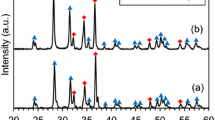Abstract
A reverse-flow reactor enables the pyrolysis of hydrocarbons at temperatures up to 2000 °C to high value petrochemical products. Materials in the reactor hot zone, exposed to such extreme temperatures, are also subject to rapid oxidative cycling over a period of several seconds between a regeneration (heat addition) step that is mildly oxidizing and a pyrolysis (cracking) step that is strongly carburizing. This paper addresses the performance of a class of zirconate ceramics such as BaZrO3, SrZrO3, and La2Zr2O7 that have been tested in a laboratory scale reverse-flow reactor and compares the results with thermodynamic predictions. It is observed that zirconate ceramics degrade by decomposition to zirconia and the second oxide, vaporization of the second oxide, and ceramic dusting corrosion of zirconia that involves carbide-oxide inter-conversion and carbon precipitation. The pyrolysis reaction promotes carbon deposition and carburization of zirconia leading to the formation of a non-protective porous carbide layer. The regeneration reaction converts the carbide layer partially back to oxide while also oxidizing away some of the deposited carbon. Repeated cycles of pyrolysis and regeneration steps eventually result in the breakup of the bulk zirconate ceramic structure into powder or dust.











Similar content being viewed by others
References
Keusenkothen PF, McCoy JN, Hey J, Hershkowitz F (2011) Pyrolysis reactor conversion of hydrocarbon feedstocks into higher value hydrocarbons. US Patent 7,914,667 B2
Chun CM, Hershkowitz F (2011) Advanced materials for regenerative pyrolysis reactors, methods, and reactors using the same. US Patent 7,976,797 B2
Mayers RA (2005) Handbook of petrochemicals production processes. McGraw-Hill, New York, NY
Chun CM, Desai S, Hershkowitz F, Keuthenkothen PF, Mohr GD, Ramanarayanan TA (2012) Int J Appl Ceram Tech. doi:10.1111_j.1744-7402.2012.02848
Chun CM, Desai S, Hershkowitz F, Ramanarayanan TA (2012) J Am Ceram Soc 95(12):3962
Chun CM, Desai S, Hershkowitz F, Ramanarayanan TA (2012) High Yttria-Zirconia and Yttria ceramics for petrochemical reverse-flow reactor applications (submitted to Int J Appl Ceram Tech)
Vassen R, Cao S, Tietz F, Basu D, Stover D (2000) J Am Ceram Soc 83(8):2023
Morita Y, Motohashi T, Sugihara S, Yamauchi H (2002) Physica C 378–38:360
Slonimskaya EA, Belyakov AV (2001) Glass Ceram 58(1-2):54
Nair J, Nair P, Doesburg GBM, Van Ommen JG, Ross JRH, Burggraaf AJ, Mizukami F (1999) J Am Ceram Soc 82(8):2066
Heuer AH, Chaim R, Lanteri V (1988) In: Somiya S, Yamamoto N, Yanegida H (ed) Advanced in ceramics vol 24A, Science and technology of zirconia III, the american ceramic society. Westerville, OH
Jacobson NS (1989) Thermodynamic properties of some metal oxide-zirconia systems. NASA Technical Memorandum 102351
Odoj R, Hilpert K (1976) Z Phys Chem Weisbaden 102(5-6):191
Odoj R, Hilpert K (1976) J Nucl Mater 60(2):216
Brett J, Seigle LL, Berkowitz-Mattuck J, Lement B, Phalen DI (1965) Experimental study of factors controlling the effectiveness of high-temperature protective coatings for tungsten. Ft. Belvoir Defense Technical Information Center
Belov AN, Semenov GA (1980) Inorg Mater 16(12):1513
Chase Jr MW, Davies CA, Downey Jr JR, Journal FD, McDonald RA, Syverud AN (1985) J Phys Chem Ref Data 14(1):927
Landolt-Börnsteink (1999) Thermodynamic properties of inorganic material, Scientific Group Thermodata Europe (SGTE). Springer, Berlin
Barin I (1993) Thermochemical data of pure substances, part I. VCH Verlags Gesellschaft, Weinheim
Dean JA (1999) Lange’s handbook of chemistry, 15th edn. McGraw-Hill, New York, NY
Acknowledgements
We would like to acknowledge insights provided by Prof. David Clarke, Harvard University and Prof. Harry Tuller, MIT. We also thank the Evans Analytical Group for their assistance in TEM investigations.
Author information
Authors and Affiliations
Corresponding author
Rights and permissions
About this article
Cite this article
Chun, C., Desai, S., Hershkowitz, F. et al. Degradation of zirconate materials in ultra-high temperature reverse-flow pyrolysis reactors. J Mater Sci 48, 3975–3984 (2013). https://doi.org/10.1007/s10853-013-7206-z
Received:
Accepted:
Published:
Issue Date:
DOI: https://doi.org/10.1007/s10853-013-7206-z




